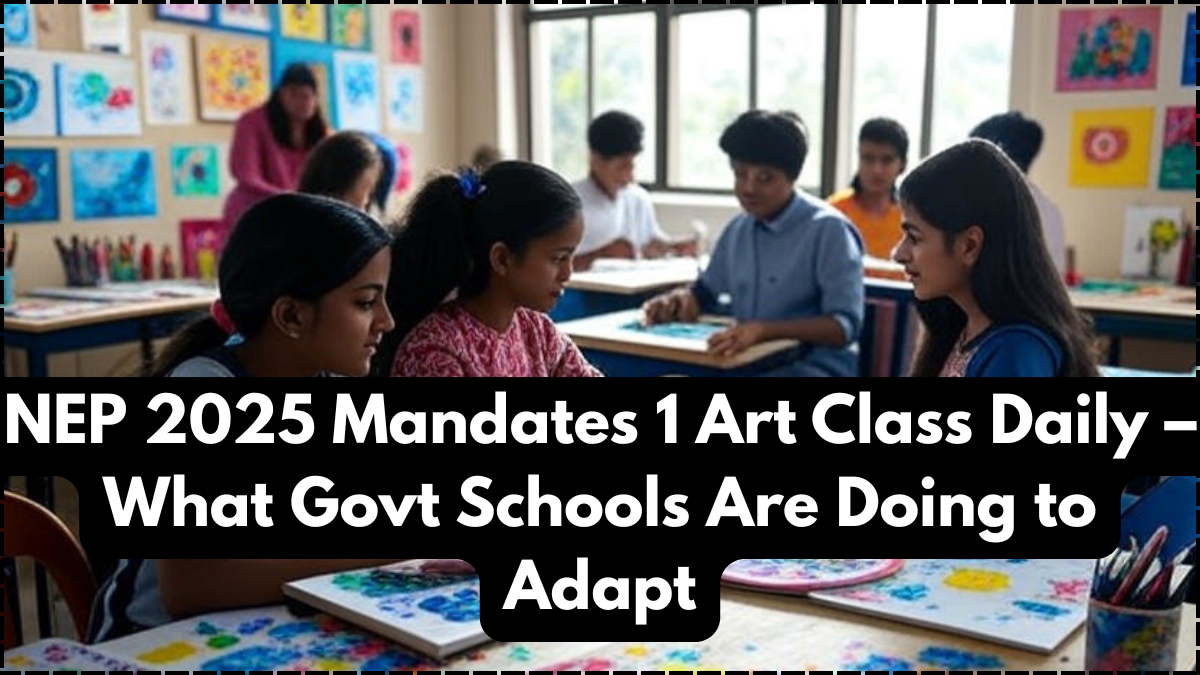The National Education Policy 2025 brings a transformative change by making art classes compulsory every day in public school curricula across India. This is the NEP 2025 art education India commitment in action — ensuring that creative expression is treated as a core subject, not a side activity. Starting this year, every art class government school is expected to deliver structured and regular art education, covering visual arts, performing arts, digital arts, and cultural crafts, depending on regional resources and talent pools.
For students, this means exposure to drawing, music, dance, theatre, or heritage craft daily — with an emphasis on creativity, cultural rootedness, and critical thinking. Teachers are being trained and resources allocated to ensure that every school has the capacity to offer meaningful and even locally relevant art curricula.

How Schools Are Structuring the Daily Art Class
Under NEP 2025 art education India, each school allocates a daily 40-minute slot for art within the school timetable. Depending on local context, schools choose from art domains including:
-
Traditional handicrafts like block printing or pottery
-
Local folk music, dance, and theatre
-
Visual arts such as painting, mural-making, and sketching
-
Digital media tools like basic animation or digital storytelling
Here’s an outline of how schools are managing art classes:
School Type |
Art Module Offered |
Teacher Profile |
Resource Support |
|---|---|---|---|
Rural Government School |
Folk painting, clay modelling |
Local craft artist or trained teacher |
Material kits + mentor visits |
Urban Public School |
Visual art, digital design basics |
Art teacher or NGO/art collective |
Tablets, design software, library |
Tribal/Special Region |
Indigenous craft or performance art |
Tribal artist or traditional mentor |
Craft material bundles + stipend |
Semi-Urban Govt School |
Music/dance blended with painting |
Part-time dance/music trainer |
Portable instruments + tools |
This flexible model allows schools to adapt art class government school activities based on local talent, teacher availability, and student interest — ensuring both tradition and innovation thrive.
Capacity Building and Teacher Training
To meet the NEP 2025 art education India mandate, state governments are organizing teacher training camps in collaboration with fine arts colleges, NGOs, and Arts Councils. These workshops span basic techniques, pedagogical methods, digital tools, and culturally contextual art forms.
Each school is allocated a Digital Art Resource Kit that includes a tablet loaded with lesson plans, DIY craft videos, and local heritage art examples. District-level resource persons provide monthly support and student showcases.
In tribal regions, special workshops invite local artists to co-teach, ensuring art class government school sessions deeply connect with community heritage.
Student Engagement and Learning Outcomes
Daily art exposure is showing promising results in student behavior, creativity, and engagement. Children are participating enthusiastically in art clubs, mural projects, and local exhibitions. Schools are hosting “Art Days” where they display student work in exhibitions open to parents and villagers.
Several pilot schools implementing NEP 2025 art education India have reported:
-
Improved attendance rates by 10–15%
-
Enhanced cross-disciplinary learning, such as art-meets-history or art-meets-environment lessons
-
Boosted confidence and expression, especially for shy or outwardly reserved students
In many art class government schools, students also join inter-school art contests, cultural competitions, and local public art mapping projects — giving their creativity external visibility.
Challenges and Innovative Solutions
Implementing this art mandate poses challenges: shortage of trained art educators, material costs, and space constraints in small schools. To address this, educational authorities are adopting hybrid models with visiting artists, digital kits, and rotating art labs. Community volunteers, parents, and senior students are being mobilized to assist during art periods.
Combination kits containing reusable materials, low-cost craft supplies, and digital lessons help keep recurring costs low. Meanwhile, partnerships with regional art colleges and NGOs allow schools without resident art teachers to host periodic “Art Weeks.”
These solutions help fulfill the art class government school requirement even in resource-limited settings.
Conclusion
The introduction of NEP 2025 art education India as a daily requirement signals a long-overdue elevation of creative learning in Indian schools. By embedding art class government school sessions into the core curriculum, children receive consistent exposure to arts that foster imagination, cultural identity, and critical thinking. Through adaptive models, teacher training, and innovative resource strategies, this policy shift can democratize creative education across rural and urban contexts alike. As it takes root, this policy promises to make India’s next generation more expressive, empathetic, and culturally grounded.
FAQs
What does NEP 2025 art education India require?
It mandates a daily art class in all government schools covering various art forms, from visual arts to performance and digital media, tailored to local contexts.
Who teaches the art classes in government schools?
Schools may employ trained art teachers, local artisans, visiting artists, or trained school staff, depending on availability and regional expertise.
What resources are provided to schools?
Each school receives a resource kit (craft materials, tablets, digital content) and access to district-level mentors and workshops.
How is student participation encouraged?
Schools host art clubs, exhibitions, inter-school contests, and community Art Days to showcase student creativity and encourage engagement.
Are there provisions for tribal or folk art-based classes?
Yes. Schools in tribal areas are encouraged to include indigenous art forms taught by traditional practitioners, ensuring cultural continuity.
Click here to learn more